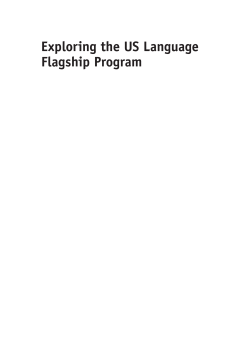
Additional Information
Book Details
Abstract
A number of reports in the US have highlighted the country’s need for improved second language skills for both national security and economic competitiveness. The Language Flagship program, launched in 2002, aims to raise expectations regarding language proficiency levels at the post-secondary level and to address structural gaps in the curricula of many L2 programs. This federally funded program provides opportunities for US undergraduate students in any specialization to reach a professional level of competence in a targeted second language by graduation. This volume highlights innovative practices that enable students to achieve this goal – even those with no exposure to the second language prior to university. This book explores the rationale and history of the federal program and showcases models and strategies of existing Flagship programs.
The American Council on the Teaching of Foreign Languages (ACTFL) enthusiastically endorses and supports the goals of the Language Flagship initiative to develop and recognize the professional language proficiency of our nation’s future leaders. Language Flagship programs are a national model for establishing proficiency outcomes, designing instruction to target benchmarks, and systematically assessing progress towards those targets. The chapters contained in this volume examine the challenges, complexities, opportunities, and successes of the Language Flagship Initiative’s innovations for language instruction in post-secondary education.
Dianna Murphy is Associate Director of the Language Institute and Russian Flagship Program at the University of Wisconsin-Madison. Her research interests are in foreign language education at the postsecondary level, with a focus on students’ goals and perspectives on their foreign language learning.
Karen Evans-Romaine is Professor of Russian in the Department of German, Nordic, and Slavic and Director of the Russian Flagship Program at the University of Wisconsin-Madison. Her research interests include Russian language pedagogy and early 20th-century Russian literature, particularly intersections of music and literature.
The Language Flagship programs represent a major initiative in language teaching and learning in the first two decades of the 21st century. As university-based Flagship programs have focused on the ambitious goals of high-level language proficiency and intercultural competence, they have naturally served as sites of curricular innovation that can inspire all of us who work in undergraduate language education. The editors have brought together an admirable collection of articles that document the origin of the Flagship, program outcomes, and a range of creative curricular paths that make this volume an essential resource.
Table of Contents
| Section Title | Page | Action | Price |
|---|---|---|---|
| Contents | v | ||
| Acknowledgements | vii | ||
| Abbreviations | ix | ||
| Contributors | xiii | ||
| Introduction | 1 | ||
| 1 The Language Flagship: Creating Expectations and Opportunities for Professional-Level Language Learning in Undergraduate Education | 9 | ||
| 2 Laying the Groundwork: Programmatic Models in US Language Flagship Programs | 29 | ||
| 3 Adding Breadth to the Undergraduate Curriculum: Flagship Approaches to Interdisciplinary Language Learning | 51 | ||
| 4 The Road Through Superior: Building Learner Independence | 70 | ||
| 5 Maximizing Oral Proficiency Development via Telecollaborative Partnerships in the Portuguese Flagship Program | 90 | ||
| 6 Creating Collaborative Communities through Online Cafés | 116 | ||
| 7 Heritage Language Learners in Flagship Programs: Motivation, Language Proficiency and Intercultural Communicative Competence | 137 | ||
| 8 Assessing Language Proficiency and Intercultural Development in the Overseas Immersion Context | 156 | ||
| 9 Overseas Internships in Advanced to Professional-Level Language Acquisition | 177 | ||
| 10 Beyond Proficiency Gains:Assessing the Academic, Cultural and Professional Impact of the Flagship Experience on Alumni | 200 | ||
| 11 Raise the Flag(ship)! Creating Hybrid Language Programs on the Flagship Model | 224 | ||
| Conclusion | 244 | ||
| Appendix A | 248 | ||
| Appendix B | 250 | ||
| Index | 253 |
